Balancing poses are interesting. Along with restoring the physical balance and correcting our posture, these Asanas also teach us how to stay grounded and balanced even when tumultuous situations strike us in life. Meanwhile, these poses could be slightly challenging if our core muscles are weak or if we are under tremendous stress. So how do we practice them? Here are seven simple balancing poses for beginners, yet effective and beginner-friendly. Use props, chairs, wall, or strap, wherever required until the poses are mastered.
7 Balancing Poses for Beginners
Tadasana looks simple, but is pretty intense and works beautifully by creating mind-body coordination. You will be able to realize the benefits of the posture only when you come on your toes and close your eyes.
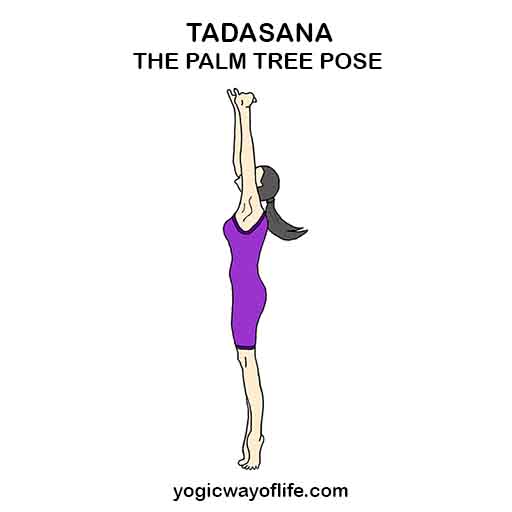
Stand with the feet separated as wide as the hips. Straighten and lengthen the spine, tucking the pelvis in. Engage the core muscles by pulling the navel close to the spine. Rest palms on the outer thighs. Roll the shoulders away and down from the ears, bringing the shoulder blades as close as possible.
Inhale and swing the arms over the head and lengthen the torso. Press the soles of the feet firmly into the floor. Take six to seven breaths here. At the end of the seventh breath, lift the heels and come on the toes. Join the palms at the heart center in Namaste. Close the eyes and fix the gaze in the space between the eyebrows. Hold the pose and balance for the next seven to nine deep breaths.
Inhale and place the heels on the floor. Exhale and release the pose.
Chair Pose is an ideal balancing pose for beginners who have a weak core.
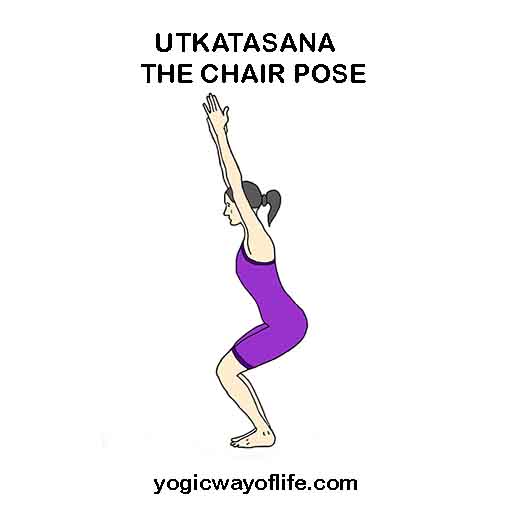
Stand erect with the feet together. Lengthen the spine, aligning it with the head and neck. Engage the core muscles by pulling the navel up and close to the spine. Tuck the tailbone inward. Roll the shoulders away and down from the ears, bringing the shoulder blades as close as possible.
Inhale and join the palms at the heart center in Namaste. Exhale and pushing the hips back. Lean forward slightly so that the torso and thighs come at 45-degree angle with each other. Stack the knees above the ankle. Ideally, thighs should come parallel to the floor. But if the knees move forward to the toes, adjust the alignment so that knees are right above the ankle. Balance here for five breaths.
On the next inhalation, lift the toes away from the floor and balance the body on the heels. Close the eyes and hold the pose for next seven to nine deep breaths.
On the final exhale, place the toes on the floor. Inhale, straighten the torso, and release the pose.
It is one of the beginner balancing poses that helps the body-mind coordination. You can practice it against a wall until you feel confident.
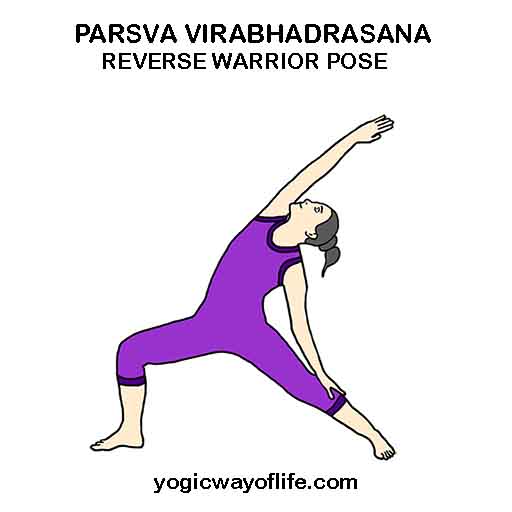
Stand with the feet together. On an inhale, step the right foot about 3 feet away from the left one. Turn the right foot slightly inward, making a 45 degrees angle with the floor. Exhale. With the next inhalation, lift the arms to shoulder level and parallel to the floor, palms facing the ground. Spread the fingers wide. Roll the shoulders down and away from the ears.
Bend the left knee, stacking it over the right ankle. Lower the hips and lengthen the spine. Allow the shin to make a 90 degrees angle with the floors that left thigh comes parallel to the floor.
Square the hips to the right side. Tuck the tailbone. Engage the abdominal muscles and suck the navel to the spine. Lower the hips down while opening the left knee to the left little toe. Hold the pose for five breaths.
On the sixth inhalation, rest the right palm on the right calf muscle. Simultaneously, lift the left arm to the ceiling, fingertips pointing to the ceiling. Indulge in a gentle back bend, sliding the right palm down towards the ankle. Gaze up and hold the Asana for the next nine breaths.
Inhale and slowly release the pose. Straighten the torso. Exhale and join the feet. Wait for a couple of breaths before repeating on the other side.
This Asana works on the entire body. It strengthens and tones the entire body. It is also a good balancing posture.
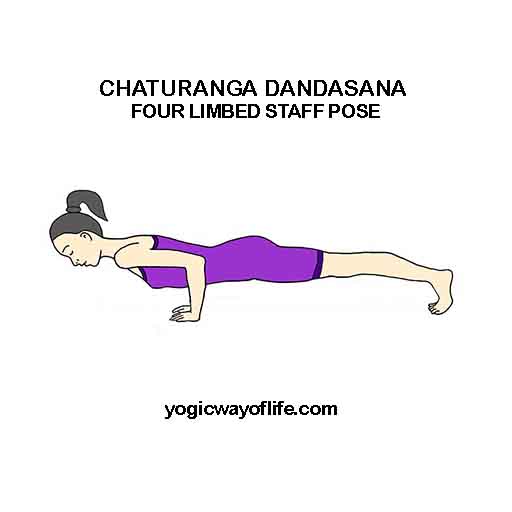
Stand erect with the feet together. Lengthen the spine, aligning it with the head and neck. Engage the core muscles by pulling the navel up and close to the spine. Tuck the tailbone inward. Roll the shoulders away and down from the ears, bringing the shoulder blades as close as possible.
Inhale and on the exhale, fold forward and place the palms firmly on the floor. Walk or jump backward and get into Plank. Exhale here and slowly lower the body close to the floor, bending the elbows backward. Tuck the toes. Engage the butt muscles, core, and thighs. In the final position, the entire body should come parallel to the floor. Hold the pose for seven to nine breaths.
Gently lie down on the floor after practicing the pose.
Balancing Table pose is the next balancing pose for beginners. The name itself says what the pose. Physically, it improves the core strength. Metaphysically, it teaches body-mind coordination and balance.
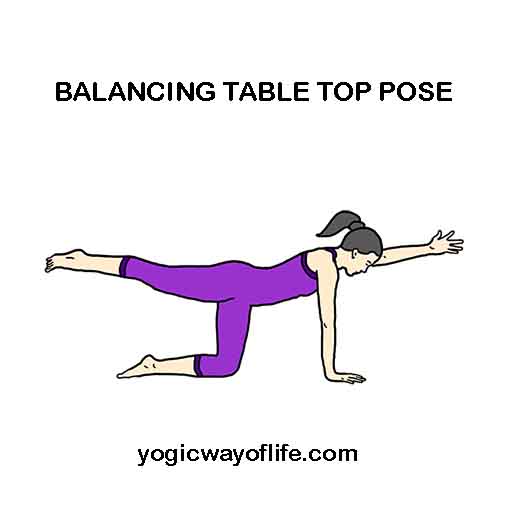
Come on all fours, stacking the hips above the knees. Align the shoulders over the wrists. Engage the core muscles by pulling the navel up and close to the spine. Roll the shoulders away and down from the ears, bringing the shoulder blades as close as possible. Extend the feet, toes pointing backward.
Inhale and lift the right leg parallel to the floor. Let the back toes reach towards the back. Inhale and lift the left arm, fingertips pointing forward. Hold the pose for three breaths. Close the eyes and bring the focus to the point between the eyebrows. Hold for the next nine breaths.
Exhale and release the left arm. Inhale and place the right leg down to come back to table pose. Repeat with the left leg and right arm.
-
Eka Pada Adho Mukha Svanasana – One-Legged Downward Facing Dog Pose
One legged Downward Facing Dog Pose is also a balancing pose for beginners. But this one is slightly trickier but helps to build a good balance.
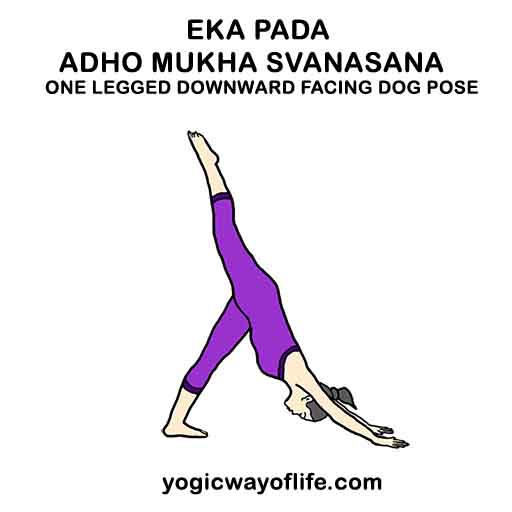
From Table Top position, inhale and lift the knees off the floor. Push the hips to the ceiling and heels to the floor. Adjust the alignment so that elbows are straight, yet unlocked. Spread the feet as wide as the hips.
Inhale and lift the right leg to the ceiling, toes pointing down. Press into the palms and left leg to balance the weight. Gaze at the thighs or navel. Hold the posture for five breaths. Exhale, bend the right knee and bring the right heel close to the buttocks, opening the right hip. Twist the torso slightly to the right and hold the posture for nine breaths.
Inhale and close the hips. Exhale and release the foot. Repeat on the other side.
The Eagle Pose is a good balancing pose for beginners. Practice the pose against the wall or by placing the toes of the top leg on the floor until you gain balance.
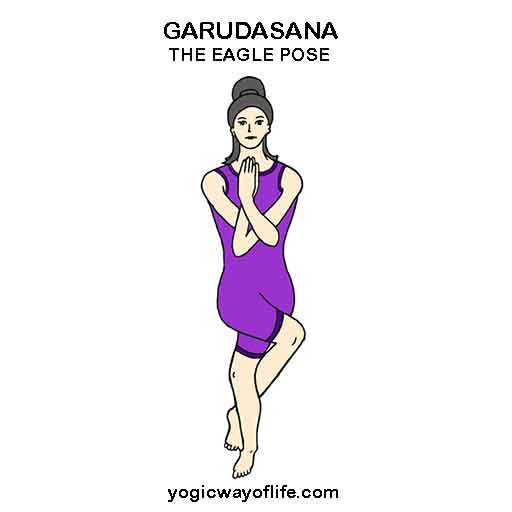
Stand erect with the feet together. Lengthen the spine, aligning it with the head and neck. Engage the core muscles by pulling the navel up and close to the spine. Tuck the tailbone inward. Roll the shoulders away and down from the ears, bringing the shoulder blades as close as possible.
Inhale and rest the palms on the waist. Exhale, bend the knees, and push the hips back, coming to a partial squat.
Stretch out the arms at shoulder level, parallel to the floor. Stretch the arms forward. Swing the left elbow over the right. Bend the elbows to bring the backs of the palms in contact. Try to hook the palms as if doing a Namaste. Do not attempt this if you have a shoulder or wrist injury. In such cases, just do a simple Namaste.
Balancing on the right leg, cross the left knee over the right. Try to hook the left ankle around the right calf. Tuck the pelvis in, engage the abdominal muscles, and straighten the spine erect. Fixing the gaze at a point in the front, sit back deeper. Hold the Asana for the next nine deep breaths.
On the final exhalation, release the palms and untwist the legs. Inhale and straighten the torso. Rest for three to five breaths before practicing on the other side.
Conclusion
There are countless balancing poses such as Virabhadrasana III, Ardha Chandrasana, Parivrtta Ardha Chandrasana, Utthita Hasta Padangusthasana, Natarajasana, Urdhva Prasarita Eka Padasana, and many more. But a strong core and an adorable body-mind coordination is essential to learn these Asanas.
Regular practice is the key to mastering balancing poses. Spend 15 to 30 minutes a day practicing these poses and feel the difference in brings to your body, mind, and soul.
